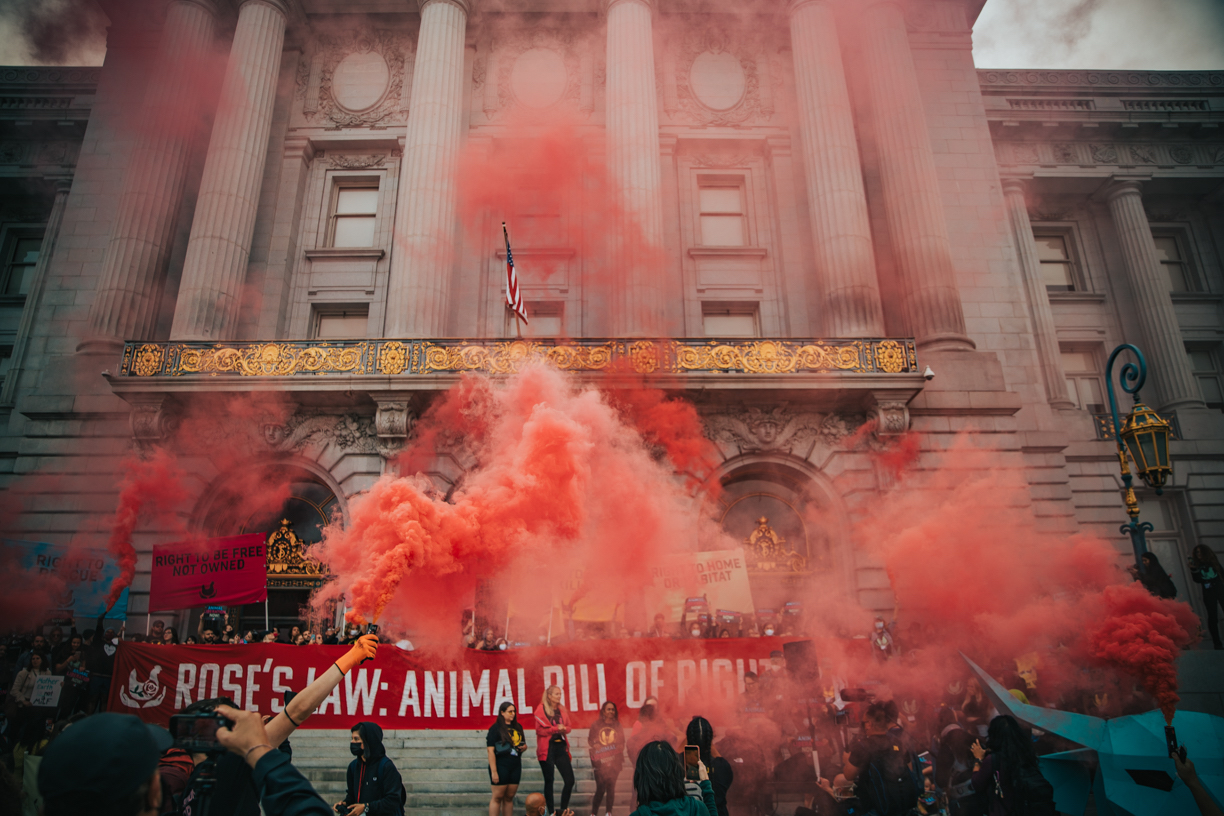Bridges and Walls

by Wayne Hsiung
One of the first times I spoke with Bob Linden, we were driving to a circus protest organized by Pat Cuviello’s group, Humanity through Education. We had just finished up our biggest mobilization to date, the Earthlings March, in which 41 cities, 17 countries, and thousands of activists participated. And we were on a high about the possibilities for bridge building in animal rights activism.
As we drove to the circus protest, with my friend Kara from LA in tow, I spoke to Kara and Bob about DxE’s role in the movement -- to build a unified network on behalf of a strong and uncompromising message; to tap into the latent potential of animal lovers everywhere to create a powerful movement for change; to adapt best practices and insights from some of the greatest scholars and activists in history to strike at the foundations of animal exploitation; and perhaps most important, to empower animal rights activists, especially from underrepresented or unexpected communities, to speak confidently for what they truly believe: the right of every animal to be safe and happy and free.

One of the things that struck me most about this conversation was that the three of us, though from completely different backgrounds, cultures, and areas of the world, all felt so strongly about these basic ideas. Kara was a younger activist from the Los Angeles scene, where there were a number of promising pressure campaigns thriving in the face of legal repression. Bob was an older activist based in the Bay Area, whose unrelenting focus on vegan education has served as a moral compass for our movement. I, in turn, was a long-time Chicago activist from an immigrant family who had been a part of virtually every animal rights campaign available for over a decade, from vegan outreach to SHAC, before settling on DxE’s current path: creating empowered networks for change. The bridges that were built on that day, across the world, and within a single car, were inspiring and powerful. And I had high hopes that they would sustain themselves over the long run.
But bridges are hard to maintain, and they sometimes fail. Even worse, the collapse of a bridge often leaves such a mess of debris that what was once a bridge is now replaced by something more intimidating than empty space: a wall. And while bridges allow us to connect, to unify, to strengthen ourselves and our entire movement through solidarity, walls do the exact opposite. They block us from, not only working together, but from even accurately perceiving what is happening on the other side.
I think that is sadly what has happened between myself and Bob, with his recent criticisms of DxE (and the similar criticisms raised of DxE by Gary Francione). A bridge has collapsed and turned into a wall. I like and respect Bob. He is brave and passionate, and he dedicates virtually every moment of his life to working for animals. We have had countless conversations about the problems the animal rights movement faces -- the constant pull of the “mainstream” to suppress not just our sadness and outrage over atrocities, but even the content of our beliefs; the intoxicating allure of money and power in subtly reshaping the activism of even the most principled individual activists; the cynicism and hopelessness that leaves activists uninspired and burned out. I still agree 100% with all of these criticisms. I still agree nearly 100% with Bob. Where I disagree is in how to change that.

Bob believes that working with industry is undermining our movement. Bob is right about this, not just on moral grounds, but because the history of welfare reforms is a terrible one, and because there’s no clear evidence that welfare reforms have, well, actually reformed welfare. The colony cages that are set to be introduced in California, to replace the battery cages that were used before, are one such example. Cages of wire have been replaced by cages of flesh.
But there is a much broader literature in moral and social psychology on the issue of “moral credentialing” -- how institutions such as Chipotle (and others before it, such as Enron or BP), which offer up meaningless badges of their so-called integrity, use their new-found moral credentials to engage in even more brutal acts of violence. I have seen these with my own eyes in working on rescues from genuinely pasture-raised farms. New forms of brutality and violence pop up to replace the old, as industry adapts to reform to ensure their astonishingly low costs are maintained. And even where reforms are not evaded or undermined, animals still live such atrociously horrible lives that it’s not clear if there are any genuine benefits. (A similar point is made in the research on human poverty alleviation. If a poor child is oppressed ultimately by institutional causes -- discrimination, inequality, and corruption -- then addressing one minor symptom, such as lack of malaria nets, might not do much to solve the problem.)
Bob also believes, however, that animal advocates who take the “welfarist” path, despite the moral and factual reasons to think it is a wrong turn, are traitors to the cause, and as bad as animal abusers themselves. And I understand this position. William Lloyd Garrison, after all, set out to undermine the mainstream “antislavery” group of his day, the ACS, because of its false compromise with slaveholders. Emmeline Pankhurst unrelentingly attacked not just the institutions of power that denied women the right to vote -- but also those women who rejected her militant tactics to force the issue with the public at large. And even Martin Luther King, Jr. decried “moderates” (who rejected the disruption of mass nonviolent direct action because it made civil rights activists seem extreme and crazy) as the great stumbling block in the nation’s stride toward freedom. There is, in short, room for harsh criticism … and, indeed, we should encourage such criticism because, as with every social justice movement before us, the debate will illuminate the path to liberation.
But that is the key -- winning the moderates over through debate, rather than destroying them. William Lloyd Garrison’s Antislavery Society was filled by one-time supporters of the ACS. Emmeline Pankhurt believed that her dream of a world where even women were free to vote was so powerful and compelling that even conservatives would eventually understand the need for direct action. And Martin Luther King, Jr., even as he angrily criticized moderates, was always animated by love and hope, rather than hostility and hate. He was humble enough to entertain criticism, and optimistic enough to believe that even the staunchest conservatives could be changed.

And in this hope, he was correct. The infamous racist and segregationist George Wallace, at the height of the Civil Rights Movement’s tumult in 1963, hatefully ranted, “Segregation now. Segregation tomorrow. Segregation forever.” And yet, within a few years, after it became clear that the cultural waves had turned against him, Wallace went on a speaking tour throughout the state of Alabama… but this time to beg forgiveness of the black families that he had so violently antagonized as a candidate for President. Wallace's story should give us hope.
And this hope, more than anything else, is perhaps where Bob and I truly disagree. Bob believes that groups such as MFA, HSUS, and Farm Sanctuary have shown us their true colors… that they are unrepentant animal killers who serve only their self-interest and bottom line. Whether accurate or not, this is a cynical view that, if not complemented by an attempt to build bridges, will only serve as a self-fulfilling prophecy. If the moderates and conservatives in animal advocacy see our grassroots movement for animal liberation as motivated by cynicism, they will have no reason to heed our calls for change. If, in contrast, they see in our criticisms a genuine and heartfelt and even desperate call to rethink our most basic strategic and moral assumptions (and an equally genuine interest in listening to criticism ourselves), then we can begin to build bridges rather than walls.
To be sure, fierce voices such as Bob’s help drive all of us to greater understanding. They push us to have dialogue -- whether within the community of radicals or between radicals and moderates. They help us identify that a gap exists, that a problem is unacknowledged, that a bridge must be built. But the fiercest critics, to be effective, must be complemented by activists just as fiercely committed to generosity, humility, and hope.
It has been said that Martin Luther King, Jr. believed that twenty percent of his work was activism. Eighty percent was dealing with internal divisions within the movement. While this is the reality of dealing with passionate people in a desperate cause, those divisions can only be healed and addressed if we talk. I hope that Bruce Friedrich and I continue to talk, despite our disagreements. I hope that Bob and I continue to talk, despite his feelings of betrayal.
But above all, I hope that all of us (including Bob) continue to speak strongly and confidently for animals, even where our voices may be unwelcome… to build bridges with even animal eaters within our communities, not to compromise our vision of a better world, but to spread our vision of a better world, with strong and committed allies, to every corner of this planet.
Because without such bridges, those who oppose us, whether in the halls of power or in a Chipotle down the street, will never find the path to the other side... the path to liberation.
Other articles

Tulare County Dairy Farms Are Poisoning Latino Communities

The Case for Systemic Change




